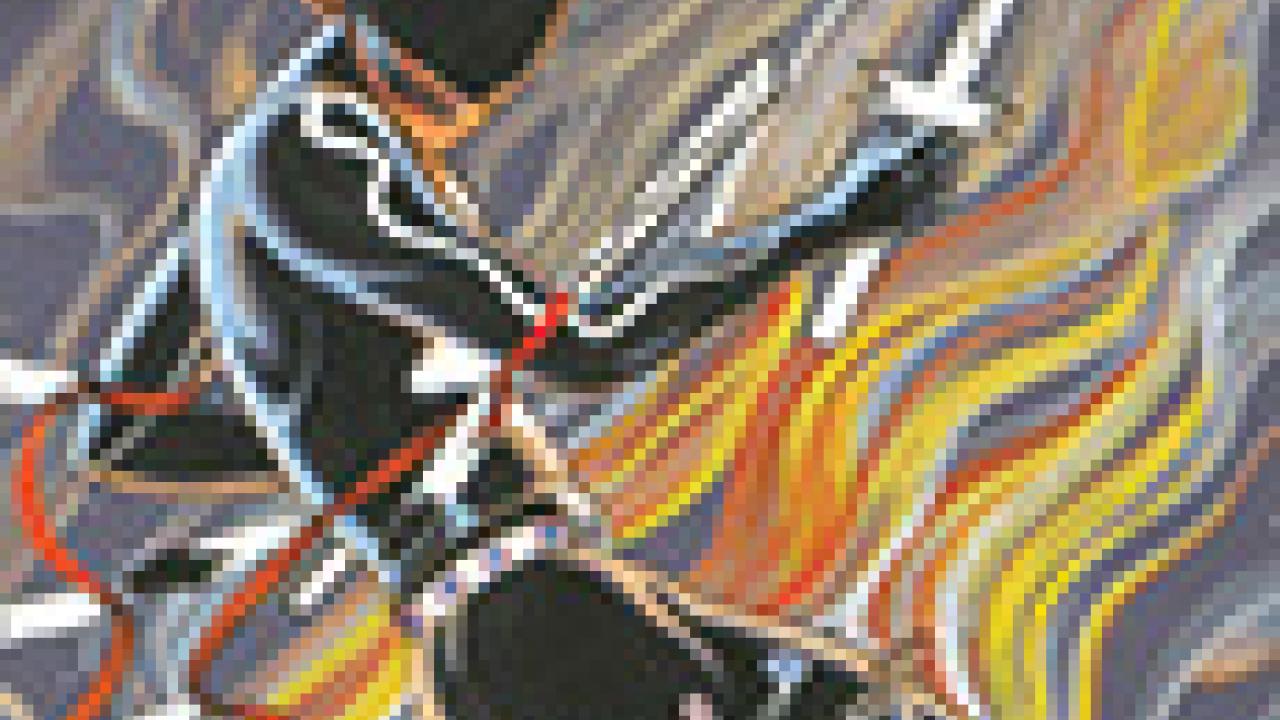The Carl N. Gorman Museum celebrates its 40th anniversary this quarter — and at a public reception later this week (see details below) — but, really, the museum started about three years earlier in a room at the Tecumseh Center.
Gorman
Navajo artist Carl Gorman, who had joined the fledgling Native American Studies Program, taught his first course in Winter 1970 — “Indian Art in Cultural Perspective,” with workshop — during which time he gathered Native American artifacts to complement his teaching.
“As interest grew, more pieces were brought in, loaned and donated by students, faculty and friends,” writes Veronica Passalacqua, the museum’s curator, in a catalog for the museum’s 40th anniversary exhibition.
The collection grew rapidly in the Tecumseh Center (an old Army barracks that housed Native American studies), and, according to Passalacqua, “Gorman’s name appeared on the door and students began referring to it as his museum.”
So did the university, officially, upon Gorman’s retirement in 1973. The museum — after the barracks and other temporary quarters — has been housed in Hart Hall since 1992.
“For 40 years, the C.N. Gorman Museum has continued Gorman’s vision of bringing Native American and Indigenous art and artists to the UC Davis campus, sharing with students, staff, faculty and regional communities the rich and diverse canon of contemporary Native American art,” Passalacqua writes.
Art from the California Academy of Sciences
In celebration of that rich history, the museum presents Foundations: Native American Art, specifically the work of key painters from the 1920s to 1970s.
“Walking through the exhibition is to revisit the foundations of contemporary Native American art, significant historical moments and the artists who formed and influenced this dynamic genre,” Passalacqua says in the catalog.
Many of the featured works, interestingly, are from the California Academy of Sciences — the Golden Gate Park landmark better known for its rainforest, planetarium and aquarium.
Delve into the academy’s Department of Anthropology, though, and you will find lesser known but extensive fine arts holdings such as the Elkus Collection of nearly 1,700 pieces of Native American art, including some 300 paintings and drawings.
Navajo and Pueblo artists of the Southwest are especially well represented in the Elkus Collection, gathered from 1922 to 1967 and including early works by some of the leading Native artists of the era.
Passalacqua and Professor Hulleah J. Tsinhnahjinnie, an artist and director of the C.N. Gorman Museum, had their pick of the collection for the Gorman exhibition.
“I love looking at collections, especially of early contemporary work, for purely selfish reasons,” Tsinhnahjinnie writes in the catalog. “I am transported back to my early years as an artist, which was nurtured by many of the Southwest and Oklahoma artists whose work is represented in the academy’s collections.
“So when Veronica and I were selecting works, it was as if I was visiting family. As I looked at works by Pablita Velarde (Aunty Pablita), I could hear the sound of her voice. When we leveled and hung the George Morrison piece, I envisioned a treasured family photo of Dad, George and me.” (Dad is the late artist Andrew Tsinajinnie, whose children’s surname differs in spelling.)
‘Negotiating their times’
In writing for the exhibition catalog, Passalacqua recalls the beginning of formalized instruction for Native artists in the 1920s and ’30s, primarily “to create a genre of Native American painting that could participate in the broader art market and appeal to modern audiences.” This instruction took place at places like the University of Oklahoma’s School of Art; Bacone College in Muscogee, Okla.; and Dorothy Dunn’s Studio at the Santa Fe (N.M.) Indian School.
A generational change occurred in the 1960s, Tsinhnahjinnie says, when “the price of getting a foot in the mainstream art world seemed to be the abandonment of a rich Native art history.”
Tsinhnahjinnie and others — “the daughters and sons of the ‘traditional’ artists, those who came from generations of artists” —continued to create art as their elders did, although most often the younger artists moved away from painting.
The anniversary exhibition, Tsinhnahjinnie says, “is but a glimpse into the incredible history of Native artists who negotiated their times to create a foundation for future Native artists.”
“These are paintings that open the mind to Southwest monsoons waking the soil, cedar fires in the night, the sound of horses breathing heavy. Navajo being spoken, the powerful songs of Oraibi.
“Through these paintings, I am reminded of how prayer used to be and the strategies of keeping grounded as a Native person in the early 20th century, utilizing any medium necessary to remember.”
This quarter, the C.N. Gorman Museum offers the opportunity for everyone to reflect on those memories — and to remember the Navajo artist who 43 years ago started the informal “museum” that grew into the real thing.
AT A GLANCE
The C.N. Gorman Museum invites the public to a reception to celebrate the museum’s 40th anniversary: 3-5 p.m. Friday, Nov. 1.
The museum is in 1316 Hart Hall. Regular hours: noon-5 p.m. Monday-Friday, and 2-5 p.m. Sunday.
The anniversary exhibition, Foundations: Native American Art, runs through Dec. 6.
Media Resources
Dave Jones, Dateline, 530-752-6556, dljones@ucdavis.edu
